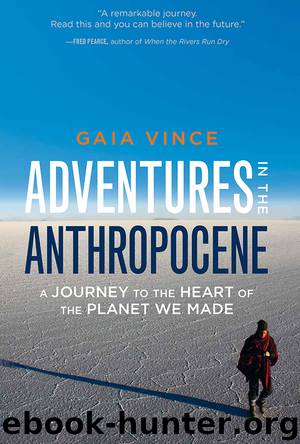Adventures in the Anthropocene by Gaia Vince

Author:Gaia Vince [Vince, Gaia]
Language: eng
Format: epub
ISBN: 9781571319289
Publisher: Milkweed Editions
7
SAVANNAHS
The first vast, treeless plains on the planet were very similar to the savannahs of today, with one major exception: grass had yet to evolve, so these ecosystems were covered in mosses, lichens, ferns and other prehistoric plants. During the Mesozoic era, herds of herbivorous dinosaurs and other reptiles roamed the savannahs, munching these plants. It wasn’t until after the Cretaceous and the extinction of the dinosaurs that grasses truly took over – they now cover 20% of Earth’s land surface.
Over time, as grasses became the dominant plant, animals evolved various adaptations to make use of this plentiful food source. Ruminants, which include cattle, antelope, sheep, camels and llamas, have four compartments in their stomachs that allow them to digest the fibrous cellulose in grass in several stages, through regurgitating. The mammals still rely on a horde of gut bacteria to crack the cellulose, and their specialised digestive tract includes fermentation chambers where the microflora do their work. Like grass, ruminants are now found on every continent bar Antarctica – wildebeest and bison chew the cud where dinosaurs once grazed.
If humans could be described as having a natural habitat it would be the savannahs. Like all predators, our ancesters were drawn to these big open grasslands, thronging with herbivores. Savannahs proved an irresistible hunting ground, with enough trees to provide shelter and firewood, but not enough cover to hide large numbers of grazing animals. It was on the African savannahs that human bipedalism emerged – our upright-walking species, with two hands free for all-important tool use and carrying capacity, owes its extraordinary success in part to changes evolved on the windswept grassy plains, millions of years ago.
Humans began ‘managing’ savannahs tens of thousands of years ago, enlarging and creating new ones by regularly burning vegetation, and cutting trees. We learned to track and outrun faster and stronger animals; and, when climate change sent the ruminants on long migrations we followed them out of Africa and across the globe. Journeying after those beasts gave humans a source of food over long distances, allowing us to trade and explore new pastures. When the world became warmer at the end of the last ice age, it was the grasses growing on savannahs that inspired the first farmers to begin cultivating crops. Settlements grew up around their fields and human civilisation emerged.
In the Anthropocene, few savannahs remain wild – the ones that do represent some of the last places on Earth of minimal human interference, where it is possible to imagine what a world without humans might look like. Most of the world’s savannahs have been converted to farmland, built upon or tamed into submissive parkland. The big wild mammals that once roamed the world’s savannahs have been hunted to extinction. In their place we have created new herbivores. Domesticated cattle, bred in just a few varieties, now graze the tamed savannahs. Death no longer comes at the jaws of a hungry predator, but is orchestrated regularly, at scale and by humans. In the Anthropocene, there is no true wilderness.
Download
This site does not store any files on its server. We only index and link to content provided by other sites. Please contact the content providers to delete copyright contents if any and email us, we'll remove relevant links or contents immediately.
Man-made Catastrophes and Risk Information Concealment by Dmitry Chernov & Didier Sornette(5647)
The Revenge of Geography: What the Map Tells Us About Coming Conflicts and the Battle Against Fate by Kaplan Robert D(3961)
Zero Waste Home by Bea Johnson(3655)
In a Sunburned Country by Bill Bryson(3364)
COSMOS by Carl Sagan(3346)
Good by S. Walden(3345)
The Fate of Rome: Climate, Disease, and the End of an Empire (The Princeton History of the Ancient World) by Kyle Harper(2870)
Camino Island by John Grisham(2719)
A Wilder Time by William E. Glassley(2689)
Organic Mushroom Farming and Mycoremediation by Tradd Cotter(2565)
The Ogre by Doug Scott(2501)
Human Dynamics Research in Smart and Connected Communities by Shih-Lung Shaw & Daniel Sui(2431)
Energy Myths and Realities by Vaclav Smil(2380)
The Traveler's Gift by Andy Andrews(2299)
9781803241661-PYTHON FOR ARCGIS PRO by Unknown(2268)
Inside the Middle East by Avi Melamed(2230)
Birds of New Guinea by Pratt Thane K.; Beehler Bruce M.; Anderton John C(2175)
A History of Warfare by John Keegan(2104)
Ultimate Navigation Manual by Lyle Brotherton(2048)
